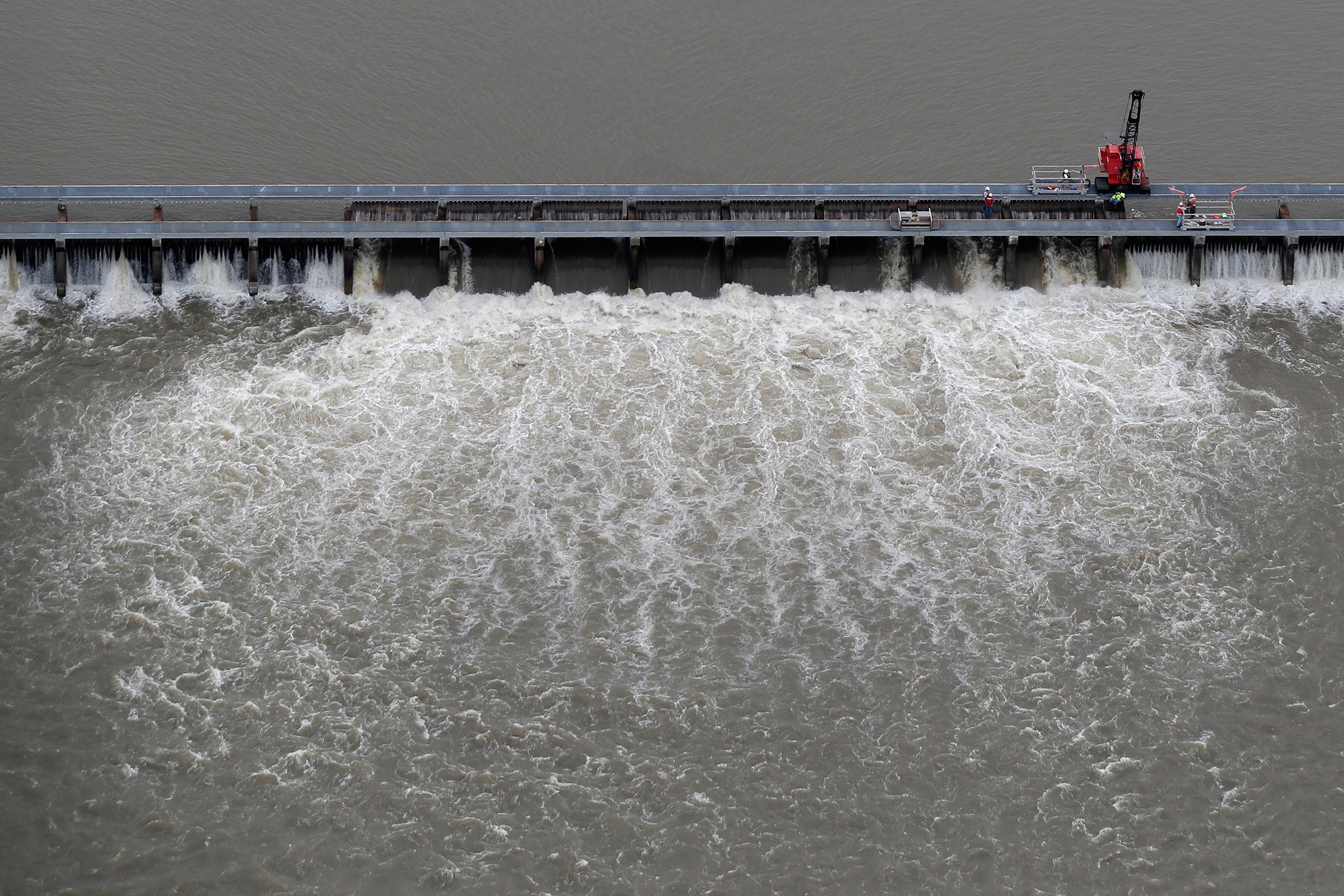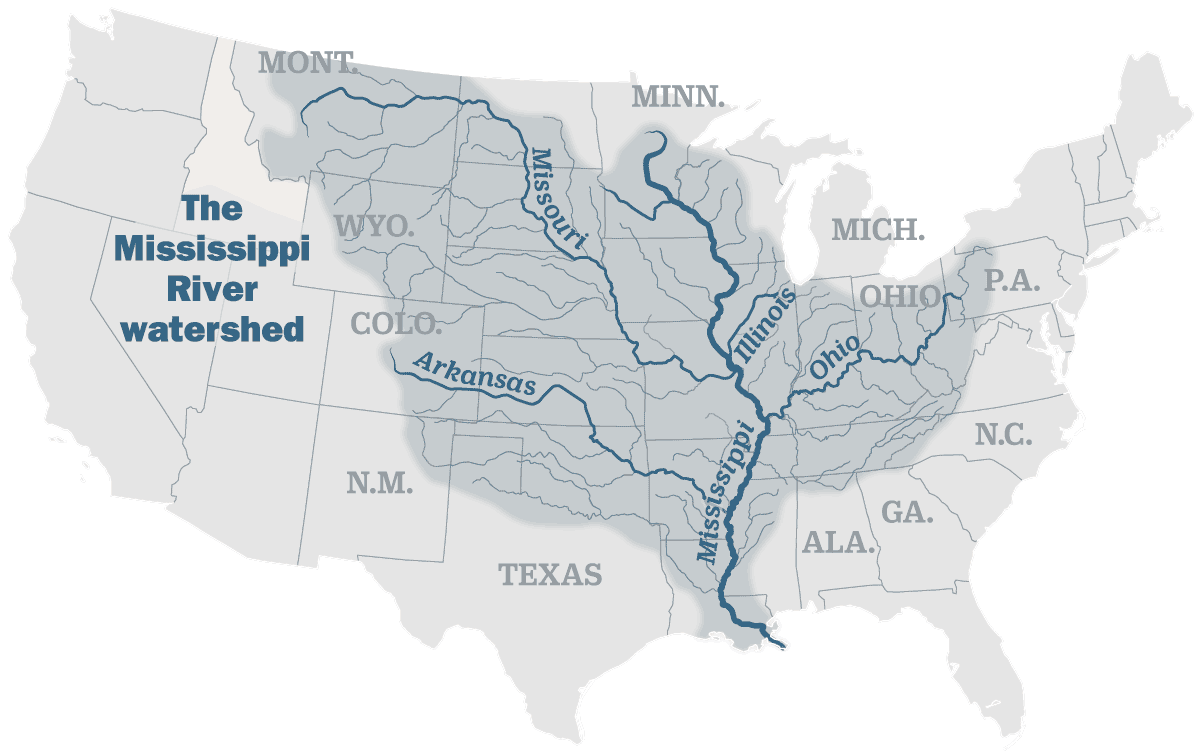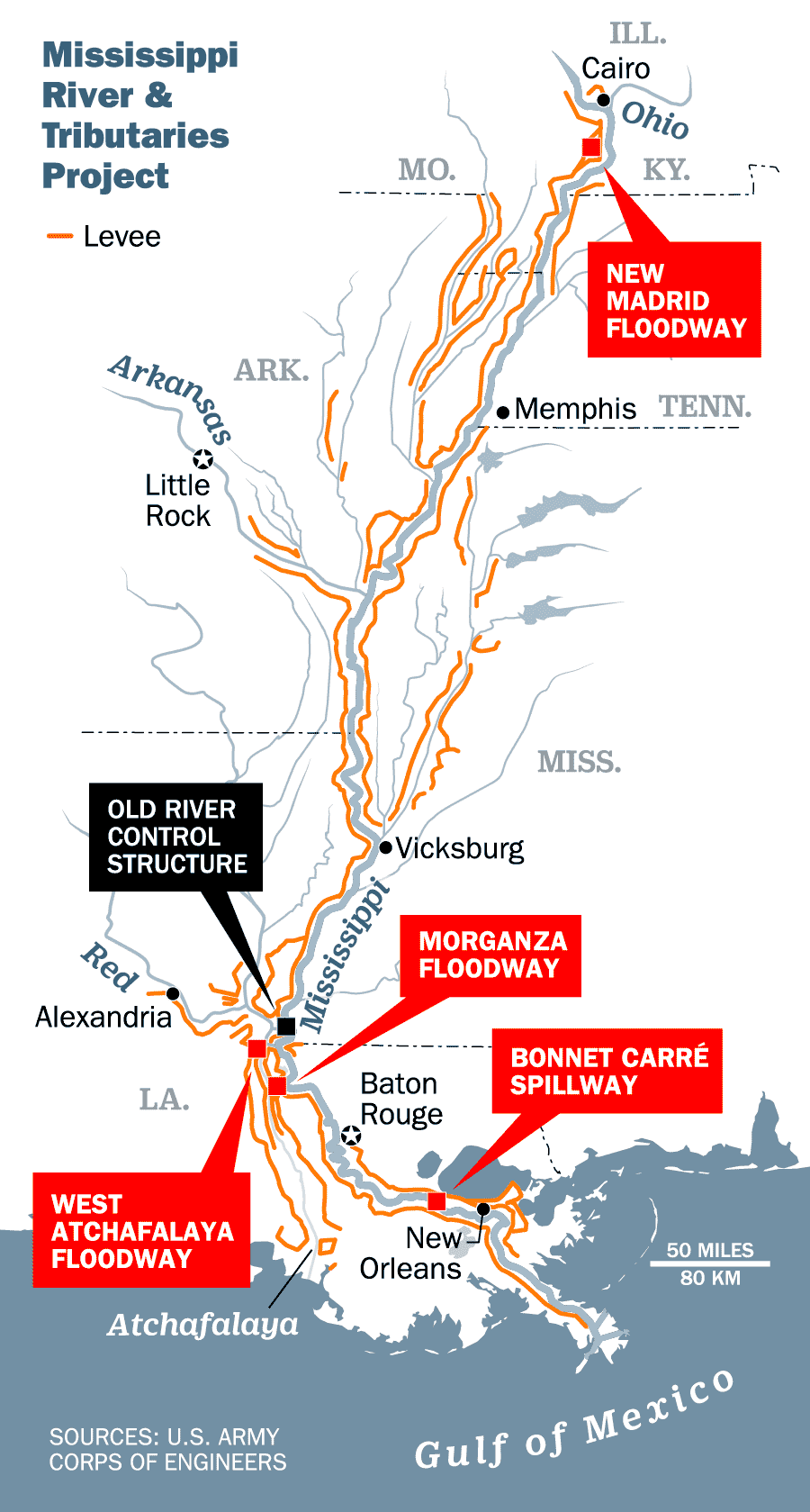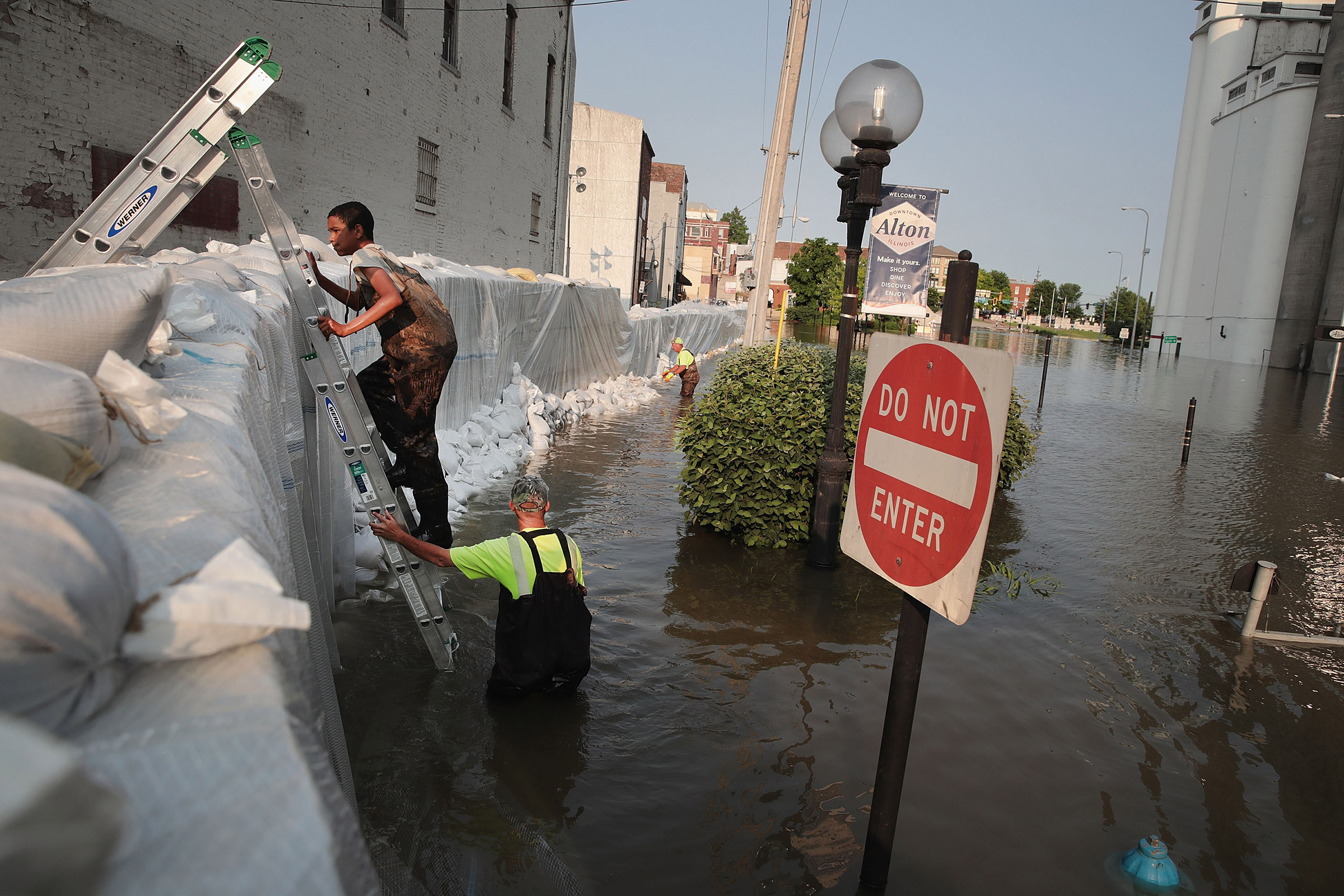
By May 9, 2019, the U.S. Army Corps of Engineers had been in a flood fight in Louisiana for nearly 200 days. Officials gathered every morning in a conference room in New Orleans that was—perhaps thankfully—windowless, keeping their opponent out of view: just below the office snarled the overladen Mississippi River, more than 8 million gallons of water ripping past each second.
That morning, the team discussed the latest forecasts and notes from inspectors, who were assessing every foot of every levee every day. They were dealing not with a river, really, but with the Mississippi River & Tributaries Project: the web of canals and spouts the lower Mississippi has become, with floodgates that can be opened or closed to redirect the water on command. The New Orleans team had been focused on the Bonnet Carré Spillway, which diverts water from the Mississippi into Lake Pontchartrain, connected to the Gulf of Mexico, during floods.
Whether to open a spillway can be an agonizing decision. When the Bonnet Carré is activated, the rush of fresh water can decimate the Gulf’s saltwater ecosystems and seafood industry. Another spillway, the Morganza Floodway, has been used so infrequently (only twice since it was built in 1954) that many people farm within its boundaries. When the Army Corps considered opening it earlier this year, ranchers scrambled to move their cattle out of harm’s way.
Over its first 80 years in operation, the Bonnet Carré spillway was activated just 10 times. Then something changed. The river hit the trigger point in 2011, 2016, 2018 and—for the first time ever in back-to-back years—February this year. Economists calculated that the opening in 2011 cost the Mississippi economy $58 million over the next few years, largely due to the reduced oyster harvest. But when the trigger point is hit, the Corps is legally bound to open the spillway, but recently, rising waters have forced the issue before it’s required.
On May 9, the leaders of the Corps’ New Orleans district announced that the river was rising again and that in five days they would reopen Bonnet Carré. “It’s a bit extraordinary,” the Corps’ emergency operations manager told the press. For the first time in history, the spillway would be operated twice in one year.
Then came the rain.
That night, so much poured over Louisiana that the river rose 6 in. Soon it would hit 17.5 ft., higher than the city had seen in more than 40 years. For Corps officials, that was too close to the tops of the levees, which sit around 20 ft. At the next morning’s meeting, they decided to open the spillway that day, immediately. Within hours a crane began to pluck wooden pins out of the spillway’s gates. The water came roaring out, the collected runoff from a flooded continent.
More trouble was on the way. Hurricane season was incipient. A storm hitting while the river was already this swollen is the stuff of nightmares; the Corps had already nearly exhausted its water diversion options. When Hurricane Barry brushed past the city in July and delivered little damage, it was both a relief and a warning shot, a reminder of what’s almost certainly to come: a flood that could sink a nation.
The Missouri, the Ohio; the Red, the Illinois, the Arkansas; the Pecatonica, the Poteau, the Big Sioux—across the U.S., rivers have swollen this year, swamping homes and cropland, costing farmers billions of dollars. Running through more than a million square miles of the heart of the United States—40% of its land area—100,000 waterways eventually drain into the Mississippi. Over 30 million people live near the Mississippi or one of its tributaries. There, on the big river, the Army Corps spent the last nine months trying to contain its longest recorded flood, the latest in an increasingly devastating series.
Scientists blame much of the epidemic of flooding on the Corps’ own engineering. In order to protect farms and cities, they built humps of earth along the Mississippi’s banks—levees, which narrowed the river, forcing it to rise. Meanwhile, countless acres of urban pavement have replaced absorbent soil. Pair these changes with the wettest 12 months in recorded history, and the Mississippi River becomes a menace.

On March 18, as the river hit the first of many crests this season, I launched a canoe near Baton Rouge, La., to study the flood from inside. I’ve spent plenty of time on the river but had rarely seen it like this. One night, the only campsite available was a set of flood-drowned trees, between which I strung a hammock. I slept uneasily, dangling above the rising water.
The river architecture—often all that stands between a town and tons of rushing water—is part highly engineered technology, part rickety old machine. Along almost every mile of the Mississippi River, levees at once control the flooding and exacerbate it. Some levees are hundreds of years old, and most are unregulated. No one actually knows how many miles of levees are on the river; there is no complete inventory. Engineers have long considered the nation’s levees to be at considerable risk, given their age and the lack of funding for repairs, and many across the Midwest either collapsed or were overtopped during this year’s floods.
Farm Market iD, an agricultural—data firm, estimates that 16 million acres of farmland—an area larger than all of West Virginia—have been affected across the Midwest this year. That reflects a choice, not an inevitability. “It’s actually national policy, if you will, to put [floodwater upriver] instead of Baton Rouge or New Orleans,” says Mark Davis, director of the Tulane Institute on Water Resources Law and Policy. The devastating flooding in the Midwest protected the South from worse floods by design.

On the lower Mississippi River—which begins in Cairo, the southernmost city in Illinois—flood control is far more advanced than in the Midwest. In 1927, floods demolished 26,000 sq. mi. of the South, killing as many as 500 people. It was the era’s Katrina, a disaster that gripped the nation. The federal government decided that the region should never be wet again, and the Army Corps was tasked with the design and construction of the Mississippi River & Tributaries Project to seize control. The MR&T is so vast that it can be hard to comprehend as a single object: it includes concrete floodwalls in New Orleans and Cairo and Caruthersville, Mo.; pumping stations that drain rainwater trapped behind these walls; and nearly 3,500 miles of levees along the river and its tributaries. A fleet of towboats and barges, outfitted with cranes and sleeping quarters for a crew of 200, descends the river each year, paving its bends with concrete to halt erosion. In the 1930s and ’40s, dredge boats straightened the river, shortening it by 150 miles, so that floodwater would speed more quickly downstream.
Politicians initially considered a more comprehensive version of the MR&T that would span the whole river, but this was deemed too expensive; the project was narrowed to just the region that had been inundated in 1927, leaving the Midwest exposed. “We’re still standing on decisions that were made two or three generations ago,” Davis says.
Still, no river as big as the Mississippi has been so thoroughly engineered.
Built in pieces over decades and still incomplete, the MR&T is designed to hold the “project design flood.” This hypothetical disaster, dreamed up in 1954, represents the largest probable flood based on historical data available at the time. The levees are designed to handle only a portion of this flood; when a trigger point is met, the Corps is authorized to open one of the MR&T’s four floodways, sending the excess water down a different route to the Gulf of Mexico. As of 2010, the Corps expected this would be necessary about once every 10 years. Bonnet Carré has been opened three times in the past 18 months.
The system is officially managed by the Mississippi River Commission, a seven-member committee appointed by the President, but is largely dominated by the U.S. Army Corps of Engineers. An elite military squadron founded by Thomas Jefferson in 1802, the Corps has grown into a massive bureaucracy, with a budget of $7 billion in 2019 for civil works. The Corps dug a tunnel in Alaska to study the effects of excavating through permafrost; it built a city in Saudi Arabia to house the country’s troops. The MR&T Project is in many ways the agency’s masterwork. Paul Hudson, a hydrologist at Leiden University in the Netherlands, calls it “among the largest and most ambitious engineering feats on earth.” The Corps’ motto seems apt: “Essayons,” French for “let us try.”
The Mississippi can be quiet and peaceful upstream, but amid the MR&T below Baton Rouge, the water slapped and jostled my canoe, its surface covered in thickets of white rapids 100 acres across. Sean Duffy, executive director for the Big River Coalition, a maritime industry lobbying group, says the Mississippi’s current state is scary for freighter pilots too, who cart oil and chemicals through the heavily populated corridor. The five deep-draft river ports in Louisiana include the largest by tonnage in the western hemisphere, and more than 500 million tons of cargo pass through this stretch each year. But the flood is affecting business: when the river is high, freighters must lighten their loads, which Duffy says can mean leaving a million dollars of cargo aside on a single trip. Amid the rain and storms, it’s clear to Duffy that the climate has changed. “Whether it’s long-term,” he says, “I can’t answer that question.”
To scientists, the answer is a resounding yes. Across the U.S., the past year has been extraordinarily rainy—nearly 8 in. wetter than usual from July 2018 to June 2019. This fits with climate-change predictions: a warm atmosphere holds more moisture in the air, which can be released suddenly, causing some regions to have more rainfall and flooding.
The Big Flood, though, will not be due to climate change alone. A paper published in Nature last year attributed up to three-quarters of the increase in flooding on the Mississippi to human engineering, especially the levees, which squeeze the river, raising its height.
There is, too, the unpredictability of man-made flood-control structures. Hudson, the Leiden University hydrologist, worries that any attempt to tame a river is a trial-and-error operation. Infrastructure is built on a much faster time scale than the river’s sedimentary processes. Once engineering is installed, the river changes—depositing new mud here, eroding banks there—and old calculations go out the window. “You’re kind of constantly keeping up with these unintended consequences,” says Hudson. It doesn’t help that much of the MR&T was designed before scientists fully understood the science of this river’s flow.
Consider one stretch of southern Louisiana where three rivers—the Mississippi, the Atchafalaya and the Red—tangle together. In the 1830s, the Corps attempted to tame the mess, straightening the path of the Mississippi. By the 1950s, scientists noticed the consequences: more water was going down the Atchafalaya River, a distributary of the Mississippi. The Corps determined that within a decade, the Atchafalaya, around a tenth as powerful as the Mississippi, might become the bigger river.
That change—which remains possible today—would devastate New Orleans. Seawater would trickle up to fill the emptied riverbed, putting the city at the edge of a brackish bayou and cutting off its access to drinking water and the riverine highway that drives its economy. The effects would ripple up the Mississippi Valley, whose farms and refineries depend on the Louisiana ports.
“It’s sinking in for everybody now. What we’ve been doing for the past 100 years isn’t working, so maybe we ought to do something else.”
The response: build more “improvements,” as the Corps once dubbed its engineering. In 1959, the Corps inaugurated a new element of the MR&T, the Old River Control Structure, at the intersection of the three rivers. The structure is a massive complex that includes 11 steel gates, embedded in a concrete wall, which are lifted and dropped by an overhead crane, regulating the flow of water from the Mississippi into the Atchafalaya, ensuring 70% stays in the bigger river. The thing looks straight out of the frozen rebel base in The Empire Strikes Back.
A massive flood in 1973 put this system to the test. A wall built to steer water toward the gates collapsed; Army Corps employees felt the structure shuddering, and scrambled to open a floodway downstream to relieve pressure. The Old River Control Structure held, but could no longer support the same capacity of water for which it was designed, so the Corps added a Band-Aid.
In May, I toured that Band-Aid: the Auxiliary Structure, just downstream. Seven concrete towers stood 40 ft. over the riverside highway. A siren wailed, a warning that one of six steel gates would soon inch upward, letting just a trickle more water through. Water slammed against the gate, coiling into a whirlpool, then dropping nearly 20 ft.—a man-made waterfall from the Mississippi into the Atchafalaya, which, in natural conditions, would be the same height.
The Band-Aid may not hold much longer. Yi Jun Xu, a hydrologist at Louisiana State University, has found that the Mississippi’s bed is rising just downstream of Old River. It’s created a pinch point that could fill with mud during a flood, forcing the water into the Atchafalaya once more.
The MR&T Project engineering has not yet been pushed to its limit: one of its four floodways has never been used. Still, the hydrologists I spoke to agreed that the system is unlikely to keep up with the increasing flooding. One model suggests that under worst-case scenarios for global heating and increasing land use, the river’s -discharge—the volume of water it carries each second—could grow by 60% before century’s end.
“That’s crazy!” Xu says. “I doubt our levee system would survive.”
There is no way to predict when the Big One will come, or what element of the system might fail. But this year’s high water signals that the Corps’ “project design flood” is already distressingly out of date. The engineering was designed around discharge readings in 1927, but today, perhaps because the flood-prevention structures have narrowed the river, the same discharge often leads to higher water than it did 90 years ago. In May, the Corps was forced to open Bonnet Carré before the discharge trigger was met because the water had risen so high.
The MR&T was also not built to contain floods, like this year’s, that stretch into hurricane season. During Katrina, the Mississippi jumped 12 ft. in New Orleans, but because the river started low, no levees overtopped. This May, when I raised the possibility of a storm surge pushing the flood over the levees with the National Hurricane Center Storm Surge Unit, Jamie Rhome, the unit’s team leader, said only that it was “a concern.”
In July, as Louisiana prepared for Hurricane Barry, the National Weather Service predicted the storm surge would push the river to 20 ft.—the same height as some of New Orleans’ levees. This was a historic warning: no completed MR&T levee has ever overtopped.
That remains true: Barry’s slow development weakened the surge, and the river stopped short of 17 ft. But the crisis showed how few options remain if another hurricane comes, this year or during a future late-season flood. The Corps is not authorized to open the spillways to accommodate a storm surge, and besides, opening the Morganza Floodway during Barry, as one Corps official told the Times-Picayune/New Orleans Advocate, “would have been a poor decision that now would actually have caused worse effects.” That’s because Barry made landfall in the same territory where Morganza would have sent the water.

The water is now slowly beginning to drop in Louisiana, but in the months and years to come it will rise again. Forced to revisit engineering decisions made decades ago, the Corps’ New Orleans office has a study under way, examining how the river’s dynamics around Old River and Morganza have changed in the past 80 years. This could lead them to issue new trigger levels. Building more infrastructure now might prove unwise. “That’s going to come with a cost,” Davis says. “Any water you stop from coming into your home goes into somebody else’s.”
The other choice is to find other places to put the water. A widely admired flood-control system in the Netherlands has a telling name: “Room for the River.” The key strategy of the system, which was completed under budget last year, is identifying land that can be reconnected to the Rhine to absorb its floods.
To retreat, rather than build, seems against the American instinct. Historically, floods in the southern U.S. have led to an increase in local populations. More river infrastructure goes up, and new people move in. So more infrastructure is built in turn. The cycle is endless—or it has been so far.
Colin Wellenkamp, executive director of the Mississippi River Cities and Towns Initiative, a coalition of riverside mayors, says he’s noted a recent change in the political tide. His organization is pushing to reconnect the river to its natural floodplains, rather than build more levees, and the past few years of flooding has driven more mayors to support those efforts. “It’s sinking in for everybody now,” Wellenkamp says. “What we’ve been doing for the past 100 years isn’t working, so maybe we ought to do something else.”
On a recent tour of river infrastructure, one reporter asked Ricky Boyett, a spokesman for the Army Corps of Engineers, what the Corps might do if the Old River Control Structure fails (again) and the river reroutes itself. Would they try to re-engineer the entire Mississippi back to its current shape? Boyett’s answer was glib: “You know, Army Corps—we can.”
Then, laughing, he backtracked. “I always say we’ve picked the worst enemy in the world, and that’s Mother Nature,” he said. “Because at the end of the day, we know that Mother Nature can do what Mother Nature wants, and we’re just trying to hold it on pause.”
More Must-Reads from TIME
- How Canada Fell Out of Love With Trudeau
- Trump Is Treating the Globe Like a Monopoly Board
- Bad Bunny On Heartbreak and New Album
- See Photos of Devastating Palisades Fire in California
- 10 Boundaries Therapists Want You to Set in the New Year
- The Motivational Trick That Makes You Exercise Harder
- Nicole Kidman Is a Pure Pleasure to Watch in Babygirl
- Column: Jimmy Carter’s Global Legacy Was Moral Clarity
Contact us at letters@time.com